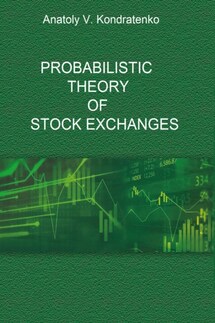Probabilistic Theory of Stock Exchanges - страница 14
The main structural element of the model is the market itself, consisting of a certain number of interacting market agents: buyers and sellers. This market is not a closed system – it is an open system, because it is under the constant influence of its institutional and external environment, as well as other markets and other sources of influence. All these factors also serve as structural elements of the market, because they exert a strong influence on market agents, and without taking it into account it is impossible to obtain a reliable description of the mechanisms of market operation and its results.
Further, in order to be able to mathematically describe the dynamics of the economy, we should, just like in physics, place the entire market into some constructed economic spaces. Since such economic spaces, in contrast to the physical space, have an auxiliary and formal character, they can be constructed in different ways depending on the tasks to be solved. In this paper, it is appropriate to use the price-quantity space corresponding to two sets of independent variables, prices P and quantities Q for all traded goods on the market (PQ-space). For clarity, we denote the names of independent variables and their corresponding coordinate axes in bold. Despite its seeming simplicity, the concept of multidimensional economic space introduced in this study is of great importance in theory, since it provides a fundamental opportunity to describe the dynamics of economic systems in mathematical and graphical languages, as it has long been accepted in science.
This paper will extensively use the notion of "market structure", which includes both the agent structure of the market itself and all significant external factors and forces of various nature that affect the operation of the market. The study of the market structure and its various microstructures and the identification of the most important characteristics and connections between them represents the most important purpose of any economic theory.
The approach of probabilistic economics, aimed at solving the problem of adequate quantitative description of each agent’s behavior in the market, as well as the behavior of the market as a whole, is based on one rather simple premise or hypothesis, which we will call an axiom. This axiom, which has a rather general character, forms the basis for the implementation of supply and demand concept in a probabilistic economy.
All market agents are identical, only their supply and demand are different. This axiom is the starting point in building up the theory. It says that in the context of studying the basic or determinant features of the behavior of market agents in the market and the market as a whole, especially in terms of the formation of market prices and trade volumes, all market agents have common or identical properties, depending mainly on the income and expenditure of agents, or, more precisely, on their S&D for the goods and services produced and traded in markets. In other words, all buyers with the same demand are identical, just as all sellers with the same supply are identical. It can also be said that such agents are indistinguishable from the point of view of influencing the outcome of market trading or exchange. This axiom is something similar to the principle of indistinguishability of particles in physics, but, naturally, it is not as strict as the principle of indistinguishability in physics. It is the S&D of agents that primarily determine their economic behavior in markets and, ultimately, the behavior of all markets; they are the only characteristics of agents and the main input data for calculation methods in probabilistic economics, i.e. the parameters that determine the studied economic system.







